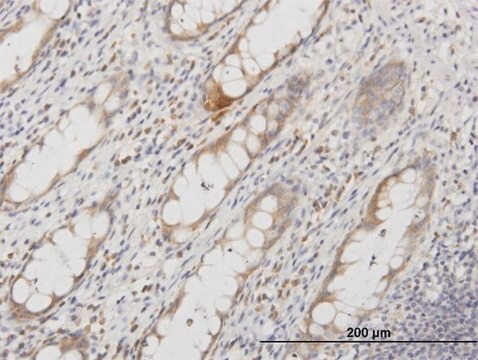A6011
Acetazolamide
≥99%, powder
Synonyme(s) :
5-Acetamido-1,3,4-thiadiazole-2-sulfonamide, N-(5-Sulfamoyl-1,3,4-thiadiazol-2-yl)acetamide, N-(5-[Aminosulfonyl]-1,3,4-thiadiazol-2-yl)acetamide
About This Item
Produits recommandés
Source biologique
synthetic
Pureté
≥99%
Forme
powder
pKa
7.2
Pf
258-259 °C
Solubilité
1 M NH4OH: 50 mg/mL
DMSO: soluble
methanol and ethanol: slightly soluble
Chaîne SMILES
CC(=O)Nc1nnc(s1)S(N)(=O)=O
InChI
1S/C4H6N4O3S2/c1-2(9)6-3-7-8-4(12-3)13(5,10)11/h1H3,(H2,5,10,11)(H,6,7,9)
Clé InChI
BZKPWHYZMXOIDC-UHFFFAOYSA-N
Informations sur le gène
human ... CA1(759) , CA12(771) , CA14(23632) , CA2(760) , CA3(761) , CA4(762) , CA5A(763) , CA5B(11238) , CA9(768)
mouse ... Car13(71934) , Car5a(12352)
rat ... Car2(54231) , Car4(29242)
Vous recherchez des produits similaires ? Visite Guide de comparaison des produits
Application
- to study its protective effect on steatotic liver grafts against cold ischemia reperfusion injury{49)
- to determine its ability to bind isolated porcine retinal pigment epithelium (RPE) melanin by cassette dosing and rapid equilibrium dialysis inserts
- to validate the in vitro gastrulation model of P19C5 stem cells for developmental toxicity screening assays
- to study its inhibitory effect on melanogenesis through enzyme kinetic, in vitro, in vivo and in silico analyses in zebrafish and in A375 human melanoma cells
Actions biochimiques/physiologiques
Mention d'avertissement
Warning
Mentions de danger
Conseils de prudence
Classification des risques
Eye Irrit. 2 - Skin Irrit. 2
Code de la classe de stockage
11 - Combustible Solids
Classe de danger pour l'eau (WGK)
WGK 3
Point d'éclair (°F)
Not applicable
Point d'éclair (°C)
Not applicable
Équipement de protection individuelle
dust mask type N95 (US), Eyeshields, Gloves
Certificats d'analyse (COA)
Recherchez un Certificats d'analyse (COA) en saisissant le numéro de lot du produit. Les numéros de lot figurent sur l'étiquette du produit après les mots "Lot" ou "Batch".
Déjà en possession de ce produit ?
Retrouvez la documentation relative aux produits que vous avez récemment achetés dans la Bibliothèque de documents.
Les clients ont également consulté
Notre équipe de scientifiques dispose d'une expérience dans tous les secteurs de la recherche, notamment en sciences de la vie, science des matériaux, synthèse chimique, chromatographie, analyse et dans de nombreux autres domaines..
Contacter notre Service technique










